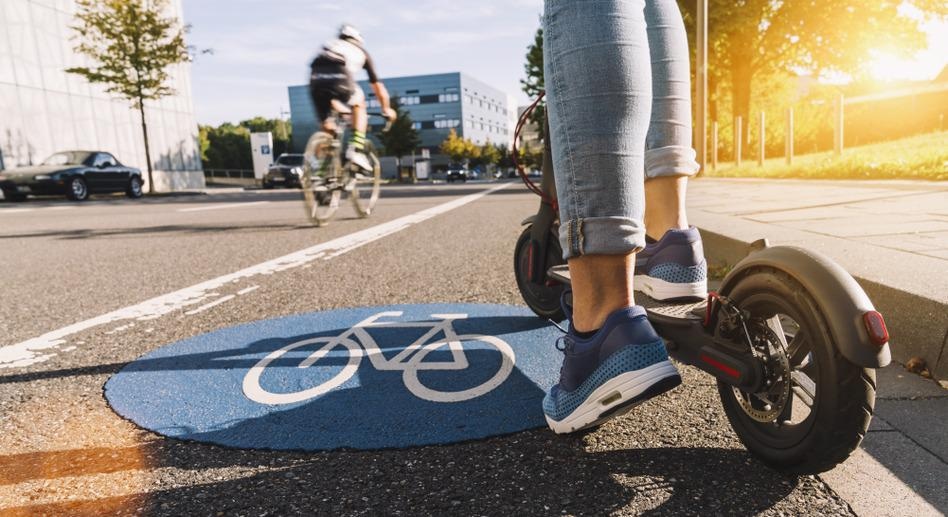An engineering company that was spun off from the Massachusetts Institute of Technology (MIT) has announced a partnership that could significantly improve safety for e-scooters and civic e-mobility schemes. By acquiring Navmatic, Superpedestrian will now be able to use Navmatic’s innovative Super Fusion technology to bolster its strong safety credentials.

Image Credit: r.classen/Shutterstock.com
Pedestrian Defense
Superpedestrian is already a leading e-mobility provider, spun off from MIT in 2013. The company provides e-scooter hire schemes to cities as well as other e-mobility solutions. It designs e-scooters with a safety-first approach.
Superpedestrian is implementing a pedestrian defense system using Navmatic’s Super Fusion sensor technology.
The system monitors unsafe riding behaviors such as riding on the sidewalk, riding in the wrong lane, fast cornering, and hard braking. The e-scooter can then be automatically slowed down or brought to a safe stop.
Superpedestrian claims that this latest development makes them the only e-mobility provider that can detect and correct unsafe behaviors across a whole fleet in real-time.
The pedestrian defense system has six main functions:
- It detects dangerous behaviors with GPS and motion sensors onboard the e-scooter
- It immediately slows the scooter down or brings it to a safe stop
- It provides alerts to rule-breaking riders with lights and voice notifications in the e-scooter
- It sends users SMS alerts, in-app rider training, and other incentives to promote good riding behavior
- It provides data and safety conditions to local governments to help them identify dangerous riding hotspots
- It creates collision reports for authorities
The data collection that the pedestrian defense system carries out will help riders, e-mobility scheme managers, and city governments alike.
Riders receive a safety rating at the end of each ride that takes their safe and unsafe riding behaviors into account. The rating is used to assign in-app and SMS safety training for riders.
If riders’ behavior improves, the system automatically grants discounts for future rides. Riders who continue to use the e-scooters unsafely are blocked from the scheme.
As well as using this sensor data for rider incentives and notifications, Superpedestrian believes that city governments and scheme managers can also benefit.
With comprehensive dashboards, officials can view safety trends on their road networks and easily spot locations with a higher likelihood of crashes or unsafe behavior.
This data can be used to support infrastructure planning decisions, maintenance, and zoning.
Superpedestrian
Superpedestrian was spun out of MIT in 2013 with the intention to bring smart and safe e-mobility solutions to the market. In 2020, the company debuted its first product: the LINK Super Scooter.
The e-scooter was designed with a safety-first approach. On-board geofences stop and slow the scooter automatically, even when it is out of cellular range.
Sensors on the e-scooters monitor the vehicle’s functionality and automatically take them out of action if they are unsafe. The same system also identifies unauthorized use, tip-overs, impacts, and theft.
Pedestrian Defense - LINK Scooters by Superpedestrian
Video Credit: Superpedestrian/YouTube.com
Navmatic Acquisition Helping Superpedestrian Solve E-Mobility Problems
Many cities have begun to restrict e-scooter use and, in some cases, banned the vehicles outright. This is due to challenges in e-mobility caused by improper use.
Assaf Biderman, Superpedestrian CEO, said:
Superpedestrian has cracked the code to one of this industry's biggest challenges. Our e-scooter is unique because it has the computing power and sensors that Navmatic's Super Fusion needs in order to operate in the field.
The acquisition was finalized in June 2021. It enables Superpedestrian to use Navmatic’s Super Fusion technology – a centralized control system combining multiple sources of real-time vehicle data.
By combining inputs from GPS hardware and onboard sensors, this technology can provide location and movement data with a high degree of accuracy – even when cellular signal is blocked.
This system will integrate with the existing sensor platform used on Superpedestrian e-scooters.
Boaz Mamo, CEO and founder of Navmatic, said:
“We've spent years at Navmatic developing the most fine-grained sensor fusion and rider behavior detection out there.”
Next Steps for Superpedestrian
The new system is currently being demonstrated in multiple pilot programs in the US. Superpedestrian hopeS a full rollout can commence later in 2021.
Biderman commented:
Now, we can scale Pedestrian Defense across our entire fleet and offer riders and cities something no other company has: a real-time solution to aggressive and unlawful riding.
Mamo added:
“We can detect how riders behave, make real-time interventions, and give cities actionable insight into the safety of their streets. This is what cities really need to solve the problems associated with e-scooters, and our team is the first and only one to achieve it.”
References and Further Reading
Bellan, Rebecca (2021) Superpedestrian Acquires Navmatic to Detect and Control Unsafe e-Scooter Rider Behavior. TechCrunch. [Online] Available at: https://techcrunch.com/2021/07/20/superpedestrian-acquires-navmatic-to-detect-and-control-unsafe-e-scooter-rider-behavior/
Superpedestrian Unlocks E-Scooter Safety Breakthrough With Acquisition of Navmatic. (2021) PR Newswire. [Online] Available at: https://www.prnewswire.com/news-releases/superpedestrian-unlocks-e-scooter-safety-breakthrough-with-acquisition-of-navmatic-883551492.html
Winn, Zach (2019) A More Intelligent System for the Scooter Wars. MIT. [Online] Available at: https://sustainability.mit.edu/article/more-intelligent-system-scooter-wars
Disclaimer: The views expressed here are those of the author expressed in their private capacity and do not necessarily represent the views of AZoM.com Limited T/A AZoNetwork the owner and operator of this website. This disclaimer forms part of the Terms and conditions of use of this website.